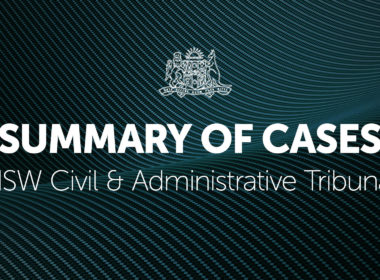Anyone who has interacted with a caveat, been involved in the lapsing of a caveat or simply lodged a caveat, will know that conflict and caveats often walk hand in hand. This is hardly surprising if you pause to consider the purpose of a caveat and reflect on the mechanism for their removal.
You may be asking yourself where is there a potential for a conflict of interest? The answer can be found in a recent trend of solicitors using caveats as a method of security for costs.
This trend has been reflected by solicitors increasingly including a “standard” provision in their costs agreement stating that they are entitled to lodge a caveat. Generally, such a provision states that the solicitor charges property in the name of the client or that they have a lien over the client’s property should the client fail to pay legal costs owing to the law practice.
However, there is an inherent tension and conflict by including such a provision in a costs agreement. A solicitor has the right to security for their costs but has to act in the best interests of their client. The recording of a caveat is hardly in the interests (let alone the best interests) of the client, particularly when you consider the consequences that flow from a caveat being recorded on a property’s title. This includes causing issues for refinancing or selling the property or leasing it. These are all actions that a caveat would act to prohibit unless the caveator’s consent is provided or the caveat is removed. Limiting an owner’s ability to refinance can be particularly devastating if they are already in financial distress.
Adding further complexity, is the fiduciary relationship between a solicitor and their client, as well as the potential impact of a “knowledge gap”. There would be few lay people who would understand what a caveat is and even fewer who would understand the impact of one recorded in the Register.
So with this in mind, let us consider some key points and issues to help understand this potential conflict. Firstly, we need to consider whether there is any legislation which provides a framework or guidelines for understanding how conflicts of interest and caveats may interact. The two main pieces of legislation to consider are:
- For caveats: – Real Property Act 1900 (Real Property Act) and the associated regulations;
- For conflict of interests (where the conflict is with the solicitor’s own interest) – the Legal Profession Uniform Law Australian Solicitors’ Conduct Rules 2015 (Conduct Rules) in particular Rule 12;
- For other fundamental ethical duties- the Conduct Rules- rule 4.
Rule 12 of the Conduct Rules governs conflict involving a solicitor’s own interest and provides the regulatory framework for navigating such potential conflicts.
The Rule states that a solicitor must not act for a client where there is a conflict between the duty to serve the best interests of a client and the interests of the solicitor, or an associate, except as permitted by the Rule.
Rule 12 is supported by Rule 4.1.1 which requires that a solicitor act in the best interests of their client. Both Rules highlight the inherent fiduciary relationship that exists between a solicitor and their client and the ethical responsibilities that the solicitor carries.
Before we dive headlong into the quagmire of potential conflict it is worth first considering some points on caveats themselves.
Caveats
This is by no means an exhaustive list of information on caveats, if it were it would be an entire novel; rather, the focus is on key points that are relevant to the consideration of caveats and conflicts of interest.
- Caveats are intended to protect estates and interests in land. This intention was set out in the second reading speech for the Real Property (Caveats) Amendment Act 1986 no 167 which inserted section 74F (into the Real Property Act (RPA)), formalising the lodgment of caveats. It is interesting to note that the second reading speech refers to solicitors sometimes lodging caveats as leverage to recover costs.
- Caveats must set out clearly the interest in the land being claimed. Practitioners should consider the Real Property Regulations (in force at the relevant time) when completing a caveat form.
- The Registrar – General (which includes the authorised operator of the Torrens Register) is not obliged to ensure that the caveator is entitled to the interest claimed. Any examination of a caveat by the Registrar-General will be to ensure that the caveat on its face complies with the requirements of the RPA.
- The caveat form includes a statutory declaration that requires the caveator or a person on their behalf to declare or swear that to the best of their knowledge the caveator has a good and valid interest in the land.
- A standard form caveat does not prohibit the registration or recording of all dealings (section 74(H)(4) of the RPA). Section 74H(5) of the RPA sets out the list of dealings that can be recorded on land, notwithstanding the lodgment of a caveat. Practitioners should note that if they amend a caveat to select all the sub sections in section 74H(5) RPA they are likely to be requisitioned to select the sub sections relevant to the interest.
- All caveats are electronic so that they must all be lodged by a subscriber, which practically means that all statutory declarations will be completed by a subscriber. At the moment subscribers are solicitors or conveyancers which could have interesting ramifications for service of notice under section 74N and for compensation under section 74P of the RPA.
- The RPA contains specific provisions which govern compensation in the event that a caveat is lodged without reasonable cause (see section 74P RPA).
Against that background, let us now turn to Rule 12 of the Conduct Rules and how conflicts are dealt with pursuant to that rule.
Rule 12
It is a cliché for people to view solicitors as less than honest or otherwise as unscrupulous, this is often how the profession is depicted in film and television. However such a view of the profession neglects to understand the layers of fiduciary and ethical obligations placed on solicitors. Nor does it reflect the high standards to which the profession seeks to hold itself.
This is reflected in the Conduct Rules and in particular the 2 rules mentioned previously. Let’s first turn to Rule 12 and how it has been considered and applied.
Rule 12 was considered by the NSW Civil and Administrative Tribunal in the Council of the Law Society v Low [2020] NSWCATOD 142. The matter concerned a solicitor borrowing money from a client, while the facts are different from lodging a caveat the Tribunal extracted commentary concerning Rule 12 generally which is of interest.
The Tribunal referred to existing case law on Rule 12 which noted the following on the relationship between solicitors and clients:
- It is inherently a fiduciary one and that solicitors are always to some extent in a position of special influence with a client.
- That clients must be able to rely on the professional advice provided by the solicitor.
- If there is a conflict between the interest of the client and the solicitor then the solicitor must act in good faith and make a full disclosure.
In circumstances where the solicitor has included a provision in their cost agreement regarding unpaid costs, how can a solicitor provide a caveat? Fortunately, the Supreme Court of NSW has considered the interplay of Rule 12 and caveats in the case of Malouf v Constantinou [2017] NSWSC 923.
Before looking at what the court said concerning the caveat and conflict, it is important to understand the facts of the matter. The solicitor was retained to act in family law proceedings during which time the relationship between the solicitor and client started to break down concerning issues with the litigation and fees.
There were five separate documents that sought to govern the relationship between the solicitor and the client, including a Deed of Charge. The net effect of the documents was that they purported to create a charge over all property (which the client owned or may own in the future) in the event of unpaid costs.
It should be noted that the client had made it clear to the solicitor that he was in a fragile financial position and that he would not be able to pay the solicitor during the progress of the matter. It appears that there may have been some discussion at this point regarding guarantees (i.e. the provision of a guarantee for the solicitor’s fees) but no discussion on what security for costs practically meant even though the cost agreement included a security clause.
Concerning the inherent conflict between a solicitor’s own interests and their clients Justice Parker noted the following:
- That there is no question that a solicitor owes fiduciary duties to his client. However, within the area of this duty not every “hope or expectation of remuneration necessarily gives rise to a conflict”. There must be a sufficient likelihood that the hope or expectation of remuneration might affect the fiduciary’s judgment.
- The costs agreement was ineptly worded in this case, and any entitlement that the solicitor had to lodge a caveat depended on whether the solicitor satisfied the requirements of the Real Property Act. Whether an interest existed (which would warrant the lodgment of a caveat) could not be determined by agreement between the parties.
- While there was nothing wrong, in principle, with the idea of a solicitor securing a client’s obligations on property, it had to be treated very carefully. This was due to the fact that by securing costs in such a way the solicitor becomes the client’s financier, as the client is being advanced the costs of the legal work. The overall effect of this that the client is locked into a dependent position with little to no control.
- Due to the point in the preceding paragraph, the court formed the view that security provisions within a costs agreement were inappropriate and that if security is to be taken then it should be documented in a separate agreement. This would provide the client with the clear opportunity to understand the separate nature of the security obligations.
- That the solicitor’s disclosure was flawed, the client and his parent’s had simply been offered an opportunity to obtain independent legal advice but they were provided with no information as to why the advice was necessary. As his Honour notes the critical requirement was not just a recommendation to obtain legal advice but rather an explanation as to why such advice was necessary.
- An all assets security was unlikely to be reasonable security as it will often exceed the amount owed.
In the matter of O’Reilly v Law Society of New South Wales (1988) 24 NSWLR, President Kirby states that solicitor’s bear a “grievous responsibility” to avoid a conflict between their personal interests and their duty to their client. This responsibility is the reason why the law demands full candor and the appropriate complete disclosure to the client.
Further in the matter of the Law Society of New South Wales v Harvey [1976] 2 NSWLR, the court held among other things, that:
- it is an essential feature of the solicitor client relationship that the client is entitled to the full benefit of the best exertions of the solicitor and that the solicitor is not permitted to make a gain for themselves at the expense of their client beyond the amount of just and fair renumeration to which they are entitled.
- Where there is conflict between the interest of the solicitor and the client it is the duty of the solicitor acting in perfect good faith to make a complete disclosure of the interest.
- If there is a conflict the solicitor should in addition to the disclosure advise the client to seek independent legal advice and should, except in the most exceptional cases, cease to act for the client.
Rule 4
While the case of the Law Society of New South Wales v Harvey was determined before the existence of Rule 4.1.1, it demonstrates that the profession has long been required to act to the benefit of their client first and foremost.
Chief Justice Street summarized the responsibility of solicitors as members of the profession as follows:
“The price of being a member of an honourable profession, whose duty to his client ought not to be prejudiced in any degree, is that a solicitor is denied the freedom to take the benefit of any opportunity to deal with persons whom he has accepted as clients.”
Rule 4 also requires that a solicitor avoid any compromise to their integrity and their professional independence. If a solicitor is finds that they have a personal interest which conflicts with their clients their ability to provide independent advice in the matter is compromised.
A solicitor could lose or undermine their ability to provide independent advice as they have in essence become a party to the transaction and they have a vested interest in a particular outcome.
All the cases referred to also highlight that it is not enough for a solicitor to highlight that there may be a conflict to their client, simply doing this does not fulfil the ethical duty to place the client’s interests first. The solicitor must provide candid disclosure and ensure that their client understands that they may need to seek independent legal advice and why they need to do so.
It may be that the result of all of this is that the client would be better served in instructing a new solicitor.
So what does that all mean?
The obvious conclusion is that conflicts of interest are not straightforward and neither are caveats and together they are more complex.
Any practitioners who have included a caveat charging provision in the costs agreement or retainer must consider whether their client understands the effect of that provision. They must also consider whether such a clause is appropriate and whether they are acting in the interests of their client.
If there is any concern regarding a conflict, a solicitor must consider the application of Rule 12 and consider seeking the full informed consent of the client to the action. It should be noted that the consent of the client may address the conflict issue however the consent of a registered proprietor to a caveat will not create an interest in land.
As the case law considered demonstrates obtaining informed consent may be impossible in circumstances where the solicitor’s own interests conflict with the client’s. If a solicitor finds themselves in this position they must ensure that their disclosure is full and appropriately candid. A lip service suggestion that their client should seek independent advice is not enough and may render any consent provided obsolete, as the consent is not informed.
Solicitors must exercise care when lodging a caveat as a method of securing their costs and consider whether such a provision should be in a separate document (as suggested in Malouf).
Additionally, solicitors must consider suggesting that their client obtain independent advice and explain to them why that is needed.
As Malouf states “Unlike a lay client, a solicitor is supposed to know the law.”




